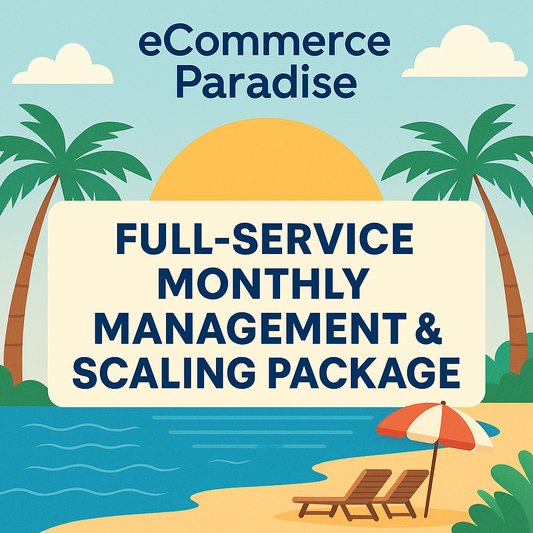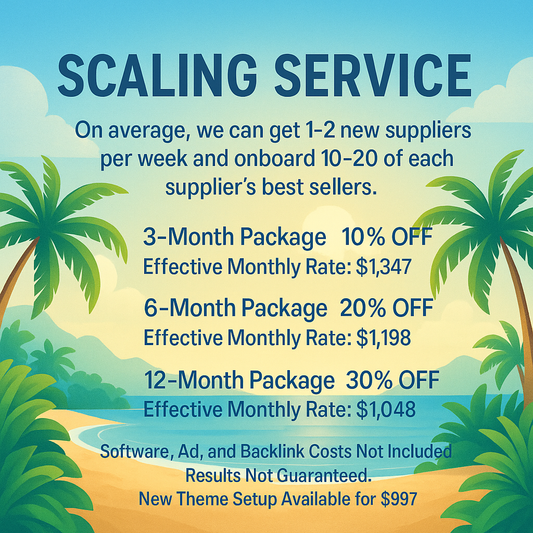
Boost Your SEO with Analytics: A Must-Do for E-commerce
Welcome to Ecommerce Paradise! I’m Trevor Fenner, and today, we’re diving into the crucial role of analytics in enhancing your SEO efforts. In the fast-paced world of e-commerce, having a strong SEO strategy is critical for success, especially when you're in the dropshipping space or you utilize Google Shopping Ads. Whether you're just starting out or looking to refine your SEO tactics, analytics is your best friend. Let's unpack how you can use analytics effectively to drive traffic and sales to your Shopify store.
Understanding the Importance of Analytics in SEO
Before we dive into the how-tos, let's clarify why analytics should be at the forefront of your SEO strategy. Understanding your audience is essential. This means knowing which keywords are driving traffic, what content resonates with your users, and how visitors behave on your site. Analytics provide you with the data needed to answer these questions, enabling you to adapt and optimize your SEO initiatives constantly.
What Can You Measure?
When it comes to SEO, there are several key performance indicators (KPIs) you should be tracking:
- Organic Traffic: The number of visitors coming from search engines.
- Bounce Rate: The percentage of visitors who leave your site after viewing only one page.
- Conversion Rate: The percentage of visitors who complete a purchase.
- Page Load Time: How fast your pages load, which can drastically affect user experience.
- Keyword Rankings: Track where your site stands for targeted SEO keywords.
Setting Up Google Analytics for Effective Tracking
Google Analytics is free and widely-used, making it an excellent tool for beginners and experts alike. Getting it set up correctly is the first step toward using data to fuel your SEO. If you’re unsure how to start, here’s a simple guide:
- Create a Google Analytics account if you don’t have one.
- Add your Shopify store as a property.
- Integrate Google Analytics with your Shopify store (there are plenty of resources to help you with this).
- Set up goals for key actions you want your visitors to complete, such as making a purchase or signing up for your email list.
Utilizing Google Analytics for SEO Improvement
Once you have Google Analytics up and running, the real fun begins. Here’s how to leverage it for improving your SEO:
Identify High-Performing Pages
Begin by navigating to the "Behavior" section of Google Analytics. This feature will help you identify which of your pages generate the most organic traffic. Are there blog posts or product pages that are particularly popular? Use these insights to:
- Create more content related to those topics.
- Optimize those pages further with internal links and relevant keywords.
Track User Engagement Metrics
It’s not just about traffic; you also want to know how engaged visitors are with your content. Look at metrics like bounce rate and time on page. If a page has a high bounce rate, it indicates that visitors aren’t finding what they’re looking for. To improve:
- Enhance the content quality and relevance.
- Ensure the page is optimized for the right keywords.
- Check that it aligns with the user intent.
Monitor Traffic Sources
Understanding where your traffic is coming from is key when building your SEO infrastructure. Under the "Acquisition" report in Google Analytics, you can see which channels drive the most organic traffic. This insight helps you focus your efforts:
- If you're getting lots of organic traffic, continue optimizing your ecommerce SEO strategy.
- If social channels are doing well, consider ramping up your email marketing efforts to convert that traffic.
Integrating SEO with Google Shopping Ads
If you’re running Google Shopping Ads, it’s crucial to ensure that your SEO and paid strategies align. Use analytics to assess which products perform well on both fronts. This allows you to:
- Identify best-sellers and optimize their product pages for SEO.
- Adjust bids on products that are likely to convert well.
Using analytic insights can help you allocate your budget more efficiently, maximizing ROI across your ads and organic strategies.
The Role of Email Marketing in Your SEO Strategy
Email marketing can significantly amplify your SEO efforts, especially if you’re dropshipping. Use your email campaigns to drive traffic back to your website:
- Include relevant product links: Drive your audience towards content that you know ranks well.
- Segment your audience: Send tailored content that meets their needs based on their behavior analytics.
- Promote new content: Share blog posts or articles that are optimized for SEO to enhance organic traffic.
Using A/B Testing to Fine-Tune Your SEO Strategy
One of the most effective ways to use analytics in your SEO efforts is through A/B testing. This involves testing different versions of a webpage to see which performs better. You can test:
- Different headlines or titles.
- Variations in product descriptions.
- Calls to action (CTA) placements.
By leveraging analytics to track the performance of these variables, you can gradually refine your pages, resulting in higher engagement and conversions.
Integrating SEO Insights Across Your Business
Make sure your findings aren’t limited to your SEO team alone. Share valuable insights from your analytics with your entire team:
- Product development can benefit from understanding which items generate the most traffic.
- Customer service can enhance responses based on common queries derived from analytics.
- Your marketing team will have a clearer picture of what content to create.
Communication is key! Utilizing data across your entire business will ensure everyone is on the same page and working towards common goals.
Common Analytics Mistakes to Avoid in Your SEO Journey
As you embark on analyzing data for your SEO efforts, here are a few pitfalls to avoid:
- Neglecting to set clear goals before analysis.
- Overlooking long-tail keywords that can boost non-competitive traffic.
- Failing to regularly review your analytics; SEO is not a one-time effort.
Staying proactive in your approach allows you to adjust strategies quickly and effectively based on solid data.
Beyond Google Analytics: Other Tools to Enhance SEO Insights
While Google Analytics is powerful, consider integrating additional tools to enhance your SEO insights:
- Google Search Console: Excellent for understanding how Google views your website and identifying issues.
- Ahrefs or SEMrush: Helpful for keyword research and backlink tracking.
- Hotjar: Offers heatmaps and session recordings to see how users interact with your pages.
Combining these insights can give you a more rounded perspective on your ever-changing SEO landscape.
Final Thoughts on Elevating Your SEO Game with Analytics
Using analytics effectively is one of the cornerstones of a successful SEO strategy. By understanding the metrics that matter, analyzing performance, and making informed adjustments, you can significantly enhance your e-commerce SEO efforts. Whether it's improving your Google Shopping Ads performance or optimizing your email marketing campaigns, data should always drive your decision-making. Remember, the ability to adapt to insights from your analytics can set you apart from competitors. Happy optimizing, and here’s to your e-commerce success!


















